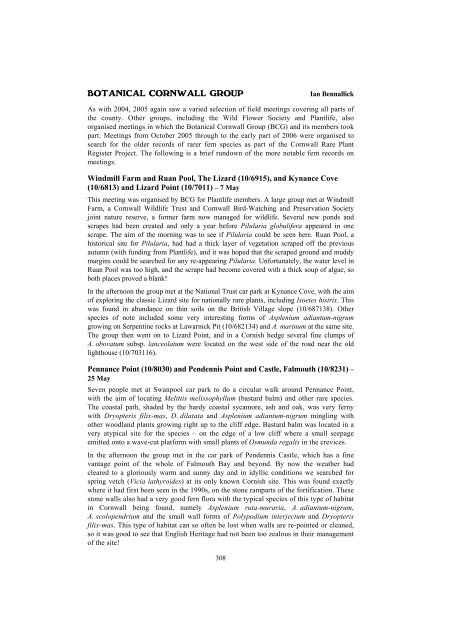REGIONAL MEETINGS - Natural History Museum
REGIONAL MEETINGS - Natural History Museum
REGIONAL MEETINGS - Natural History Museum
Create successful ePaper yourself
Turn your PDF publications into a flip-book with our unique Google optimized e-Paper software.
BOTANICAL CORNWALL GROUP Ian Bennallick<br />
As with 2004, 2005 again saw a varied selection of field meetings covering all parts of<br />
the county. Other groups, including the Wild Flower Society and Plantlife, also<br />
organised meetings in which the Botanical Cornwall Group (BCG) and its members took<br />
part. Meetings from October 2005 through to the early part of 2006 were organised to<br />
search for the older records of rarer fern species as part of the Cornwall Rare Plant<br />
Register Project. The following is a brief rundown of the more notable fern records on<br />
meetings.<br />
Windmill Farm and Ruan Pool, The Lizard (10/6915), and Kynance Cove<br />
(10/6813) and Lizard Point (10/7011) – 7 May<br />
This meeting was organised by BCG for Plantlife members. A large group met at Windmill<br />
Farm, a Cornwall Wildlife Trust and Cornwall Bird-Watching and Preservation Society<br />
joint nature reserve, a former farm now managed for wildlife. Several new ponds and<br />
scrapes had been created and only a year before Pilularia globulifera appeared in one<br />
scrape. The aim of the morning was to see if Pilularia could be seen here. Ruan Pool, a<br />
historical site for Pilularia, had had a thick layer of vegetation scraped off the previous<br />
autumn (with funding from Plantlife), and it was hoped that the scraped ground and muddy<br />
margins could be searched for any re-appearing Pilularia. Unfortunately, the water level in<br />
Ruan Pool was too high, and the scrape had become covered with a thick soup of algae, so<br />
both places proved a blank!<br />
In the afternoon the group met at the National Trust car park at Kynance Cove, with the aim<br />
of exploring the classic Lizard site for nationally rare plants, including Isoetes histrix. This<br />
was found in abundance on thin soils on the British Village slope (10/687138). Other<br />
species of note included some very interesting forms of Asplenium adiantum-nigrum<br />
growing on Serpentine rocks at Lawarnick Pit (10/682134) and A. marinum at the same site.<br />
The group then went on to Lizard Point, and in a Cornish hedge several fine clumps of<br />
A. obovatum subsp. lanceolatum were located on the west side of the road near the old<br />
lighthouse (10/703116).<br />
Pennance Point (10/8030) and Pendennis Point and Castle, Falmouth (10/8231) –<br />
25 May<br />
Seven people met at Swanpool car park to do a circular walk around Pennance Point,<br />
with the aim of locating Melittis melissophyllum (bastard balm) and other rare species.<br />
The coastal path, shaded by the hardy coastal sycamore, ash and oak, was very ferny<br />
with Dryopteris filix-mas, D. dilatata and Asplenium adiantum-nigrum mingling with<br />
other woodland plants growing right up to the cliff edge. Bastard balm was located in a<br />
very atypical site for the species – on the edge of a low cliff where a small seepage<br />
emitted onto a wave-cut platform with small plants of Osmunda regalis in the crevices.<br />
In the afternoon the group met in the car park of Pendennis Castle, which has a fine<br />
vantage point of the whole of Falmouth Bay and beyond. By now the weather had<br />
cleared to a gloriously warm and sunny day and in idyllic conditions we searched for<br />
spring vetch (Vicia lathyroides) at its only known Cornish site. This was found exactly<br />
where it had first been seen in the 1990s, on the stone ramparts of the fortification. These<br />
stone walls also had a very good fern flora with the typical species of this type of habitat<br />
in Cornwall being found, namely Asplenium ruta-muraria, A. adiantum-nigrum,<br />
A. scolopendrium and the small wall forms of Polypodium interjectum and Dryopteris<br />
filix-mas. This type of habitat can so often be lost when walls are re-pointed or cleaned,<br />
so it was good to see that English Heritage had not been too zealous in their management<br />
of the site!<br />
308
















